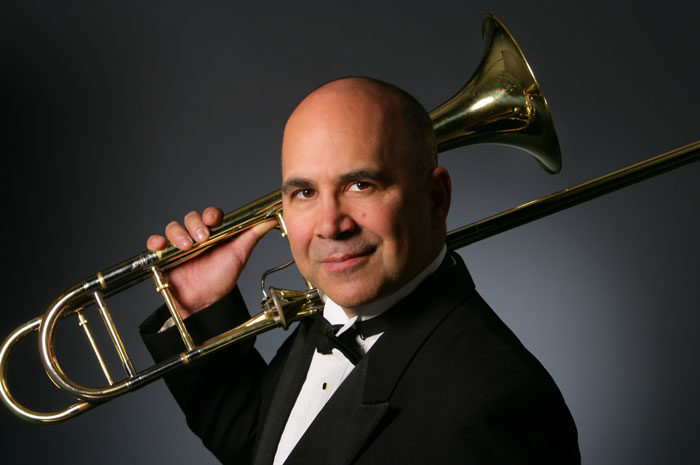New York Philharmonic’s Alessi gives brilliant advocacy to trombone concerto with Frost Wind Ensemble

Joseph Alessi, principal trombone of the New York Philharmonic, performed John Mackey's "Harvest Concerto" Tuesday night in Miami with the Frost Wind Ensemble.
The Frost Wind Ensemble, in pre-holiday mode, made a joyful noise Tuesday night at the University of Miami’s Gusman Concert Hall, offering recent scores by John Mackey and Steven Bryant alongside an American classic.
Assistant conductor Christopher Cicconi opened the proceedings with the band version of “Profanation,” the second movement of Leonard Bernstein’s Symphony No.1 (Jeremiah). Although the early score is based on the Lamentations of Jeremiah, the brash, jazzy vigor of this 1942 scherzo presages Bernstein’s Fancy Free and West Side Story. This excerpt is quintessential Bernstein and Cicconi’s crisp performance captured that up-tempo, brightly colored musical aura. The ensemble’s blazing brass and xylophone inflected percussion did full justice to Bernstein’s brand of biblical Americana.
John Mackey wrote his Harvest Concerto in 2009 for trombonist Joseph Alessi, a legendary pedagogue at the Juilliard School and longtime principal with the New York Philharmonic. In many ways this recent piece’s juxtaposition with the Bernstein work was totally appropriate since Mackey’s flashy concerto has a similar irrepressible zest and spontaneity.
Mackey based his work on the myth of the Greek god Dionysus with the trombone as the voice of the protagonist. You have to love a piece that pays tribute to the god of wine and ecstasy and Mackey does not disappoint. In three connected sections, the eighteen-minute concerto is a cycloramic feast of shifting moods and instrumental hues. After initial, barely audible rumblings, the trombone emerges with wild, strident motifs against the raucous ensemble in a festive celebration only to conclude with a descending solo slide as one life cycle ends. Depicting winter, the second section features a haunting, sadly inflected melody for the solo trombone, underpinned by prominent roles for the harp and piano. In the festive rebirth and bacchanalia of the finale, short, tangy figurations bubble up from the ensemble as the trombone throws off rapid leaps, the winter theme returning triumphantly at the work’s conclusion.
Mackey’s instrumental mastery and melodic invention carry the day and he could not have asked for a more brilliant advocate than Alessi. Whether spinning the long, winding melodic lines of the slow movement, the fast slides and groans of the ecstatic rituals or the pyrotechnical tour de force of the final section, Alessi showed himself an absolute master of the instrument. More than mere accuracy and high gloss virtuosity, Alessi brought color, subtlety and passion to Mackey’s impressive showpiece. A tireless advocate for contemporary wind ensemble scores, Gary Green conducted with hard-driving vigor, drawing incisive, unbridled playing from the ensemble. Alessi, Mackey and Green received a prolonged, cheering ovation.
Steven Bryant’s Concerto for Wind Ensemble was initially a short work composed in 2007 for the United States Air Force Band of Mid America. In 2010 Bryant added four more movements as a commission from a consortium of music schools, including UM Frost. Bryant’s aim was to display the virtuosity of the ensemble, the concert band equivalent of Bartok’s Concerto for Orchestra. Employing a surround0-sound perspective, the composer places players at the sides and rear of the hall.
There are striking moments in Bryant’s work. The first fortissimo roar of the full ensemble and antiphonal forces perks up the ears. A moody horn solo over mallet percussion provides a striking interlude. The dense figurations of two flutes with tinkling harp dot the second movement. A jazz tune played on the trumpet by the composer’s father years ago becomes the principal thematic material of the light, dashing third movement. The gloomy heaviness of the following segment is considerably less appealing and the pealing brass chorales and full-throttle percussion of the conclusion sound like innumerable other contemporary fanfares. Ultimately, the fragments do not coalesce into a tightly conceived whole, and Bryant’s piece has more rhetoric than substance.
The score does succeed in providing a bravura ensemble vehicle that requires every instrument and section to play to the very limits of their capacity. Under Green’s enthusiastic leadership, the Frost players emerged triumphant. This fall the greatly improved quality of student players at UM’s music school has been consistently impressive and the Frost Wind Ensemble’s performance of Bryant’s challenging work was dazzling.